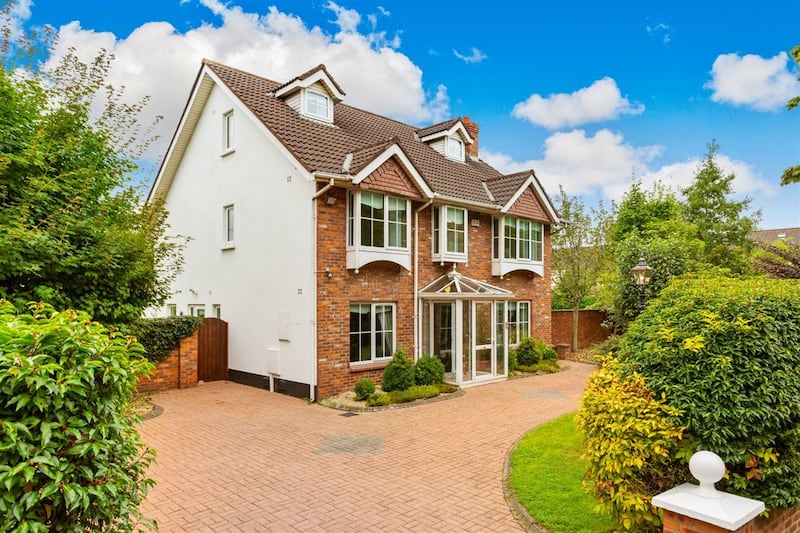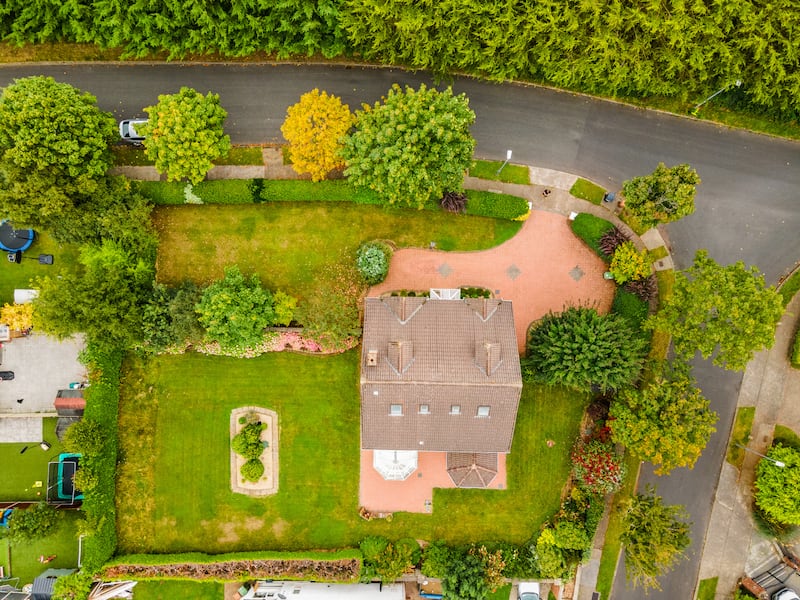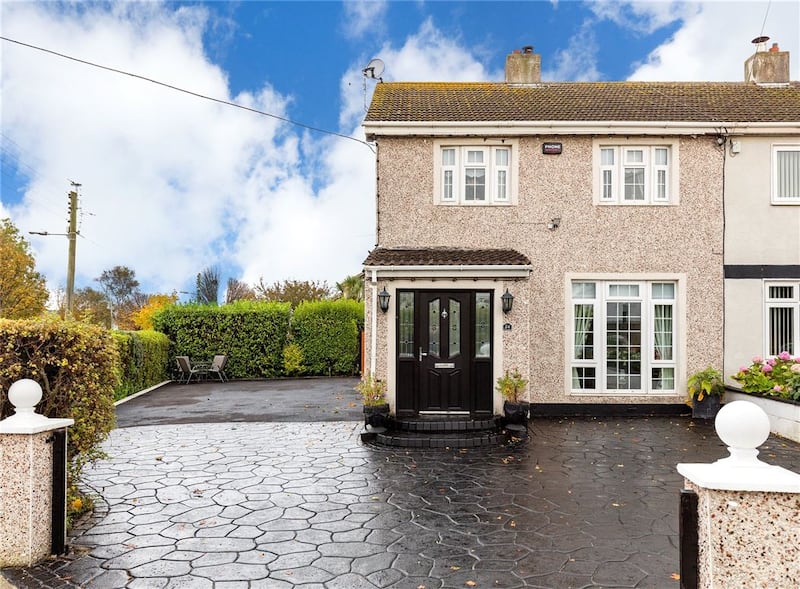If your home has a large garden, then you may be sitting on some money. Selling a site, developing it yourself or gifting it to a family member are all ways to monetise what’s under your nose. By doing it right you can unlock value, be tax efficient and maybe even house the next generation.
Cash out
When it comes to wringing value from a home with a big garden, there are a few routes. The most straightforward is to sell the whole kit and caboodle, without applying for planning permission, with “development potential” writ large on the brochure.
No 19 College Gate in Castleknock, in northwest Dublin, is a prime example where the owners are selling the house and plot together. Its generous corner site, with a substantial green area to the side, of about 0.3ac, gives the property obvious potential. Similar houses in the area sell for €900,000, says Conor Toolan, manager of Sherry FitzGerald in Castleknock, but the extra value of a potential site lifts this one to €1.2 million.
What adds value here is that the potential site is to the side of the main house, so building on it won’t affect what you can see from the existing home’s front and back windows. The plot is also large enough to leave two houses with generous gardens. Building here shouldn’t significantly diminish the value of the original house.


But size isn’t everything, and not every house with this size of a garden can expect to command such a premium. “There is great demand for infill sites, but it does depend on the area,” says Toolan. With the cost of building through the roof right now, a finished home will have to achieve a sale price that adequately compensates a developer for what it paid for the site.
“If that property was in a lower-capital-value area, the final completion cost of the house may be well in excess of what the area can command,” he says. Sometimes it just doesn’t make sense. “In some areas you can purchase a property for cheaper than you would be able to build.”
So just because you have a big garden with room to build a house, it doesn’t automatically mean you can make money from developing it. When pricing it to sell, take into account building costs and property values in your area.
“Sites can be more attractive to a builder or developer or a buyer who has contacts to get the work done below market rate,” says Toolan. “A smaller site with potential for a two- or three-bed semi will be more affordable for someone who doesn’t have experience, but to take on a site at scale you will need some level of industry knowledge.”
Planning permission
Another route to monetising your garden is to secure planning permission first. This can add value as it eliminates the planning risk for the buyer, allows them to envisage what is possible on the site, and saves time.
Toolan gives the example of 24 Grange Park Drive in Raheny, a three-bed end-of terrace with an extrawide space to the side. The house is for sale for €550,000 with full planning permission to build a three-bed, two-storey house in that space. Planners can be positively disposed towards infill housing like this, as densification generally benefits a city. A similar property on this terrace, also a semi-detached three-bed, but without a site, sold for €108,000 less last year. Identifying the potential for a site and getting planning permission for it add value.

When it comes to establishing if your plot has potential, how big is big enough?
There are no hard and fast rules, says Graham Kennedy of Plan 8 Architects, in Delgany, Co Wicklow. When giving permission for a new dwelling on the site, the planners take into account the size of the existing home. "You've got to leave the existing house with a certain amount of garden space and circulation space."
There isn't a standard minimum garden size for dwellings, either. "In Wicklow, it's a rate per floor area of the house. For other authorities, the garden will have to be x size for a certain number of bedrooms."
Car parking isn’t a deal-breaker, either: it’s more about the quality of the amenity space, he says. Any plans will need to avoid overlooking neighbours, too, or at least mitigate that. “It’s not to say you can’t have any windows on that side availing of the light. A design solution can give the new house the benefit of that light while protecting neighbours’ privacy.”
If you have a big garden, building another family home in it can be a tax-efficient way to share wealth. With housing in short supply, and values in childhood neighbourhoods out of reach for first-time buyers, the garden can provide a way in
Another thing planners look for is fit with existing houses in the area. If a neighbour has already done something similar, this will improve your chances.
The planning process is not always straightforward, of course – just ask Sean FitzPatrick, the former chairman of Anglo Irish Bank. He has sought planning permission for not one but two new houses in the Old Burnaby area of Greystones, in Co Wicklow. The FitzPatricks secured planning permission for a four-bedroom home last December, granted by An Bord Pleanála after the local council refused it.
They are going through the planning hoops for another house now, in the rear garden of that house. Wicklow County Council has, however, refused permission for this proposed new two-storey, four-bedroom home.
Local residents objected, and the council said the location of the planned home, in a rear garden of a permitted dwelling, meant the proposal would lead to a cramped and uncharacteristic form of development.
The planners said the proposal involved subdividing a plot and creating a more intense density than was normal in the area. They also said the planned home had an uncharacteristic design and form for the area and for the size of the site.
Spread the love
If you have a big garden, building another family home in it can be a tax-efficient way of sharing wealth. With housing in short supply, and values in childhood neighbourhoods out of reach for some first-time buyers, the garden can provide a way in.
“It can be a win-win for parents for whom the garden is too big to manage and they want to have family close by. It’s very hard to monetise the value of that,” says Kennedy.
Alternatively, parents may opt to pass on the family home and right-size themselves to a comfortable new-build on site. Either way, there is the potential to create a house with a high building energy rating, built to their exact specifications, and on a mature site, for less than they might pay on the open market. And of course they’ll know the neighbours.
If you gift a plot in your garden to your child, he or she can receive it to the value of €335,000 tax-free. 'One thing to note is that this is a lifetime threshold, so any future gifts or inheritances will be subject to 33% capital acquisitions tax'
One such success story is evident as soon as you see what happened when the owners of a substantial period home in Bray, Co Wicklow, gifted a site at the bottom of their garden to a son, says Kennedy, the architect on the project.
The plot, which covered 300-350sq m, now accommodates an impressive four-bedroom home measuring about 140sq m. “The plot had dual access, so it was easier to separate from the existing dwelling,” says Kennedy. “The finished build cost on this ended up at about €2,300 per square metre” (excluding site costs, consultants’ fees and VAT).
“One of the challenges with this project was retaining and protecting the many existing specimen trees,” says Kennedy. The mature setting adds character and value to the modern build.
A back-garden build can be an option in a more modest setting, too, he says. “Some council houses from the 1950s and 1960s have long, narrow gardens – the concept was that you could keep livestock and a vegetable garden and become self-sufficient. Some also had a septic tank. With services now coming to the front door, that big garden is no longer needed.”
Such a site could be gifted or sold to family who can go about getting their own mortgage to develop it.
Avoid tax
Whether you split a folio and sell a site in the garden, or sell the house with planning for a second house, makes no difference when it comes to tax, says Marian Ryan of Taxback. com.
“In both circumstances what’s taken into account is the value of the property when you purchased it, the sale price and whether or not the property was your principal private residence for any part of time.”
You are exempt from capital gains tax if you sell a property that, for the entire period of ownership, you lived in as your main residence. This exemption also applies to up to 1ac (0.4ha) of land around a house.
But this principal-private-residence relief is restricted if, among other reasons, the sale price has “development value”. This refers to the higher potential value your property has compared with how you currently use it. If you sell your home and land of up to 1ac for its development value, PPR relief applies only to the value of the house or land without its development value.
If you fancy building a more modern house in your large garden, selling off your original home when it’s time to move in, you will also be eligible to claim PPR relief, says Ryan. Again, the exemption applies to land up to 1ac around the house.
If you gift a plot in your garden to your child, he or she can receive it to the value of €335,000 tax-free. “One thing to note is that this €335,000 is a lifetime threshold, so any future gifts or inheritances you give them will be subject to capital acquisitions tax of 33 per cent,” says Ryan. For example, if the site is worth €200,000 and you leave your child €250,000 in your will – a lifetime total of €450,000 – your child will pay 33 per cent tax on the €115,000 over the threshold.













